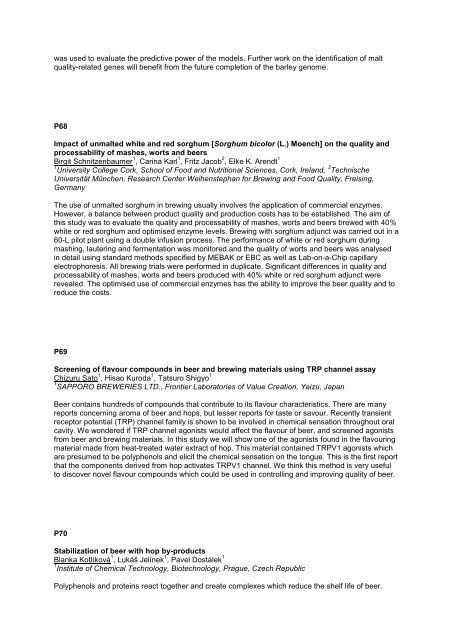here - the 34th European Brewery Convention
here - the 34th European Brewery Convention
here - the 34th European Brewery Convention
Create successful ePaper yourself
Turn your PDF publications into a flip-book with our unique Google optimized e-Paper software.
was used to evaluate <strong>the</strong> predictive power of <strong>the</strong> models. Fur<strong>the</strong>r work on <strong>the</strong> identification of malt<br />
quality-related genes will benefit from <strong>the</strong> future completion of <strong>the</strong> barley genome.<br />
P68<br />
Impact of unmalted white and red sorghum [Sorghum bicolor (L.) Moench] on <strong>the</strong> quality and<br />
processability of mashes, worts and beers<br />
Birgit Schnitzenbaumer 1 , Carina Karl 1 , Fritz Jacob 2 , Elke K. Arendt 1<br />
1 University College Cork, School of Food and Nutritional Sciences, Cork, Ireland, 2 Technische<br />
Universität München, Research Center Weihenstephan for Brewing and Food Quality, Freising,<br />
Germany<br />
The use of unmalted sorghum in brewing usually involves <strong>the</strong> application of commercial enzymes.<br />
However, a balance between product quality and production costs has to be established. The aim of<br />
this study was to evaluate <strong>the</strong> quality and processability of mashes, worts and beers brewed with 40%<br />
white or red sorghum and optimised enzyme levels. Brewing with sorghum adjunct was carried out in a<br />
60-L pilot plant using a double infusion process. The performance of white or red sorghum during<br />
mashing, lautering and fermentation was monitored and <strong>the</strong> quality of worts and beers was analysed<br />
in detail using standard methods specified by MEBAK or EBC as well as Lab-on-a-Chip capillary<br />
electrophoresis. All brewing trials were performed in duplicate. Significant differences in quality and<br />
processability of mashes, worts and beers produced with 40% white or red sorghum adjunct were<br />
revealed. The optimised use of commercial enzymes has <strong>the</strong> ability to improve <strong>the</strong> beer quality and to<br />
reduce <strong>the</strong> costs.<br />
P69<br />
Screening of flavour compounds in beer and brewing materials using TRP channel assay<br />
Chizuru Sato 1 , Hisao Kuroda 1 , Tatsuro Shigyo 1<br />
1 SAPPORO BREWERIES LTD., Frontier Laboratories of Value Creation, Yaizu, Japan<br />
Beer contains hundreds of compounds that contribute to its flavour characteristics. T<strong>here</strong> are many<br />
reports concerning aroma of beer and hops, but lesser reports for taste or savour. Recently transient<br />
receptor potential (TRP) channel family is shown to be involved in chemical sensation throughout oral<br />
cavity. We wondered if TRP channel agonists would affect <strong>the</strong> flavour of beer, and screened agonists<br />
from beer and brewing materials. In this study we will show one of <strong>the</strong> agonists found in <strong>the</strong> flavouring<br />
material made from heat-treated water extract of hop. This material contained TRPV1 agonists which<br />
are presumed to be polyphenols and elicit <strong>the</strong> chemical sensation on <strong>the</strong> tongue. This is <strong>the</strong> first report<br />
that <strong>the</strong> components derived from hop activates TRPV1 channel. We think this method is very useful<br />
to discover novel flavour compounds which could be used in controlling and improving quality of beer.<br />
P70<br />
Stabilization of beer with hop by-products<br />
Blanka Kotlíková 1 , Lukáš Jelínek 1 , Pavel Dostálek 1<br />
1 Institute of Chemical Technology, Biotechnology, Prague, Czech Republic<br />
Polyphenols and proteins react toge<strong>the</strong>r and create complexes which reduce <strong>the</strong> shelf life of beer.





